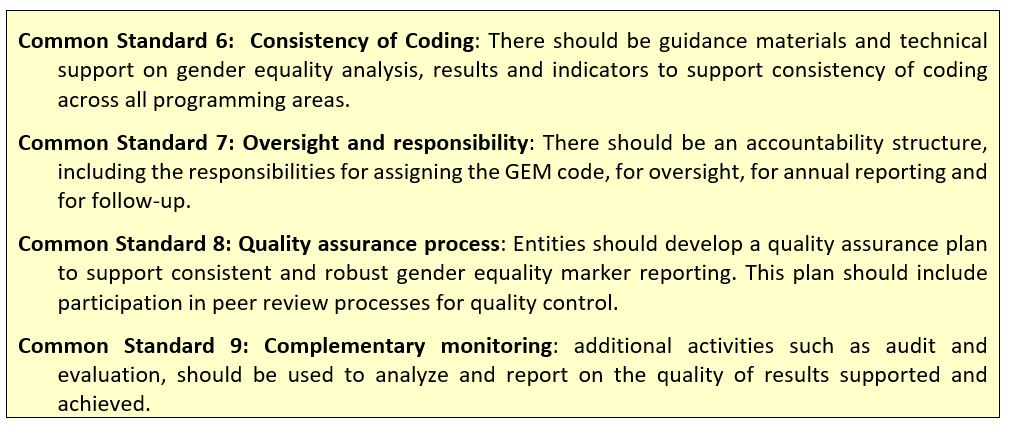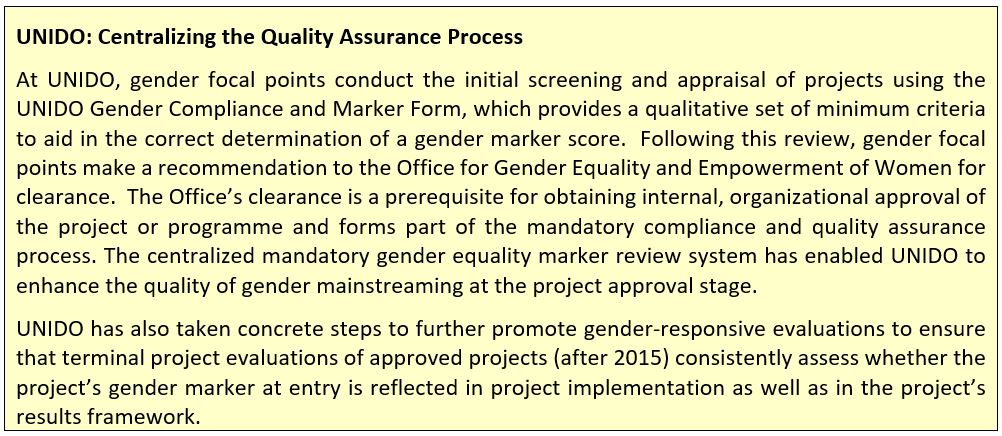6.1 Process

Source: UNDG Guidance note (2013)
Investing in strong quality assurance mechanisms and processes is integral to ensuring the reliability, accuracy and consistency of the gender equality marker by ensuring that codes are applied correctly and monitored transparently within broader accountability processes.
Gender Units (i.e., gender advisors/gender specialists and gender focal points) at global, regional and country levels play an important role in overseeing and assuring the accurate and consistent use of the gender equality marker. Some of the common measures that Gender Units have taken include:
- Developing and updating internal guidance, templates and tools on the use and application of the gender equality marker;
- Building staff capacities on establishing a common understanding of the definitions of the gender equality marker codes and criteria through staff trainings or other learning platforms. (Global and country)
- Providing technical support primarily through gender units, gender advisors or gender focal points to support consistency in coding;
- Conducting systematic checks to validate the gender equality marker score before the approval of the project.
Quality assurance primarily takes place at the programme/project planning stage. Many UN entities, especially the Funds and Programmes, have put in place a decentralized, quality assurance process, where the technical and quality assurance support is provided at the level where it is needed. Smaller (technical) entities have instituted a more centralized quality assurance system that requires projects, including the gender equality marker, to be cleared and approved by the Gender Office; while pooled funds have put in place a multi-tier review structure that can span country and global levels. See examples below.


There are positive shifts being made by some entities to strengthen the quality assurance process of the gender equality marker beyond the planning stage. By reviewing the gender equality marker at the implementation stage, issues of over-coding or under-coding can be addressed or coding anomalies be identified. It also creates another opportunity to work with programme managers and staff to build capacities on the more accurate application of the gender equality marker. Moreover, these periodic checks enable programme teams to ensure that financial allocations align with financial expenditures.
UNFPA, for example, undertakes an annual spot check on a random selection of activities to identify and correct any anomalies in gender equality marker tagging and addresses them with concerned offices. The Peacebuilding Support Office, led by the Gender Advisor, undertakes an end-of-year quality assurance review of projects which have been approved in a given year to validate the assigned gender marker code for each project and to ensure that financial allocations made to gender equality reconcile with that score. Following the review, gender marker scores are adjusted, either upwards or downwards.

As this section details, there are a range of actions at different levels as well as at different intervals of the programme/project cycle that entities can design their quality assurance process. What is important is to develop and put in place a quality assurance plan to support consistent and robust reporting.
